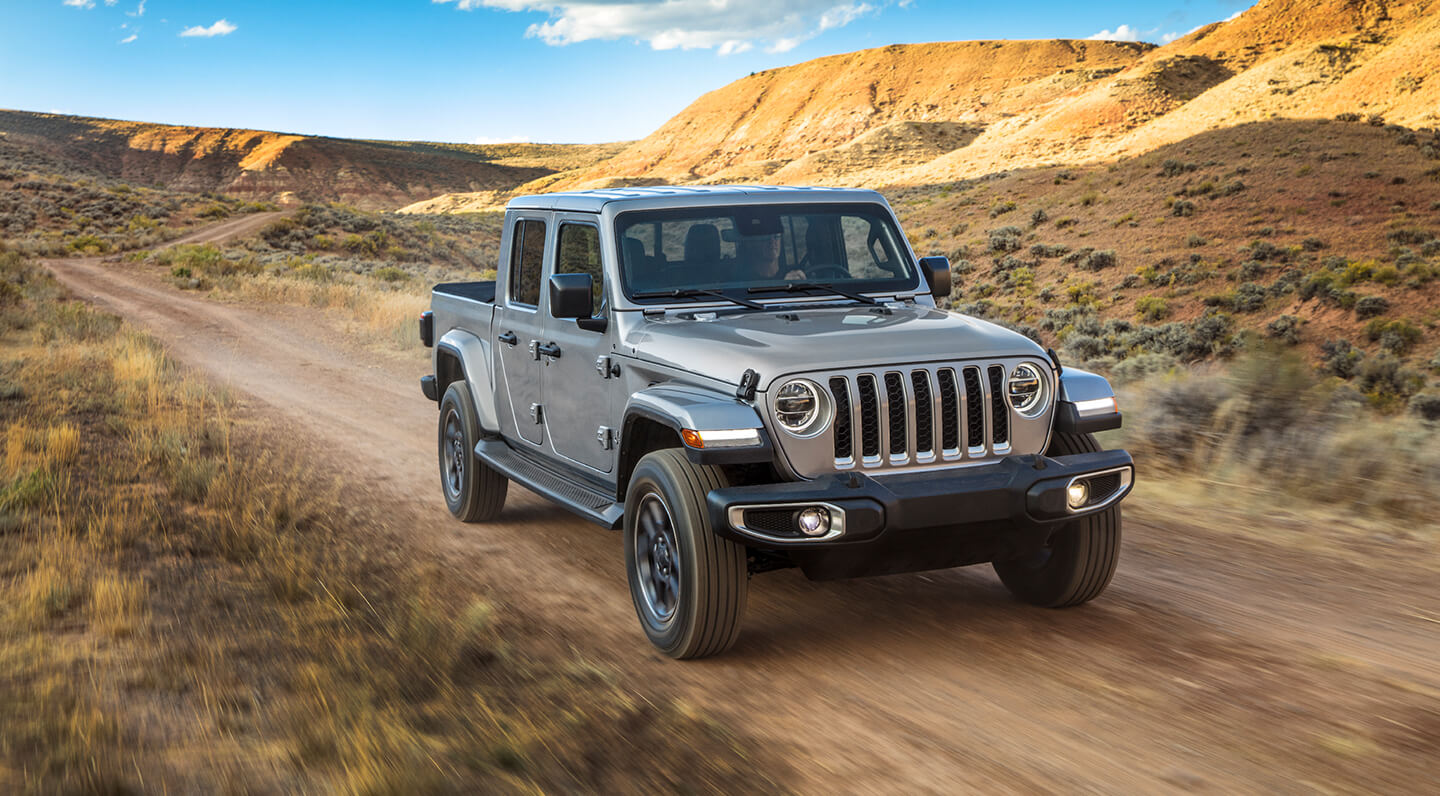
It’s been a long, slow tease. Not too long after the last Comanche ended production back in 1992, new Jeep Wrangler-based pickup kits began to surface. The sweet-looking TJ-generation AEV Brute truck appeared and, later on, the JK-based four-door Brute pickup also came on the scene. Mopar even got into the act with a JK-8 kit that allowed owners to convert their own four-door Wranglers into trucks. As good as some of these options were, none of them were thoroughly vetted and tested production machines straight from the Jeep factory—until now.
The 2020 Jeep Gladiator is finally here. The new truck takes its name from the full-size Gladiator J-truck pickups from 1963-87. One look at the frontend and cab, and it’s clear the Gladiator JT is based on the new Wrangler JL. And that’s no bad thing. Jeep moved 240,000 Wranglers in 2018, an increase of around 50,000 over the year before and a record for the brand. Jeep is anticipating similar levels of success when it comes to the Gladiator. In fact, a whole new production line was added at the Toledo Assembly Complex to meet what’s sure to be a strong demand for the truck.
The Jeep Gladiator should be a great machine in the dirt. But there’s only one way to find out. So, we secured the first one we could get our paws on—a Gladiator Sport S. We spent a week with the truck and hammered it on the streets and all around Los Angeles. But more importantly, we spent a day in the dirt four wheeling the truck on the trails. Let’s find out if the Gladiator was worth the wait.
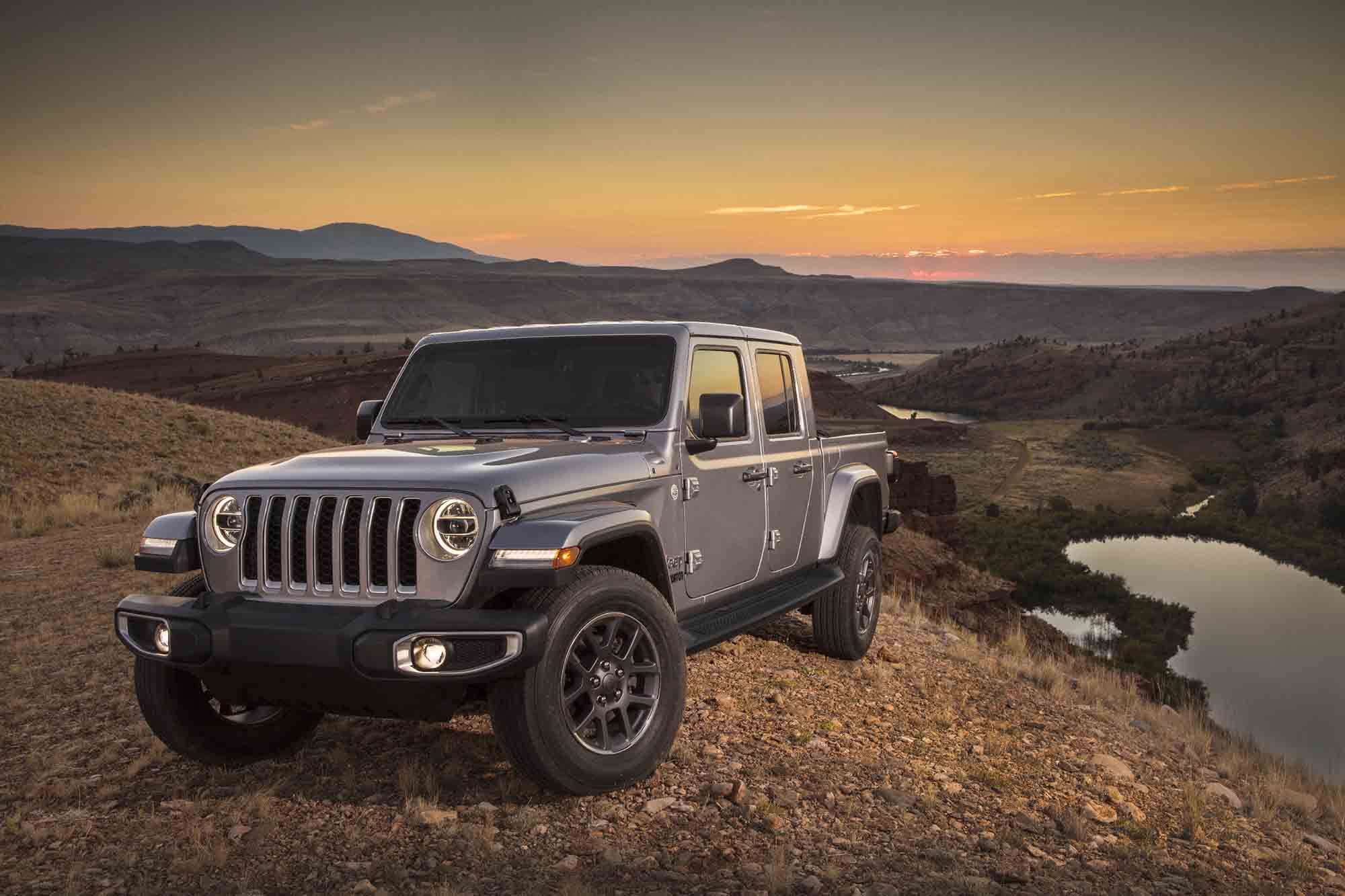
The Hardware
The Gladiator shares quite a bit with the Wrangler, but it’s more than just a stretched JL with a 5-foot bed on the back. Yes, the Gladiator chassis is similar to the Wrangler, but from the cab back it’s all-new. The wheelbase was stretched by 18.9 inches to 137.3 inches. And, to meet the safety and durability requirements of this new pickup, chief engineer Pete Milo says the frame was beefed up along with the cross members. In addition, the team added new hydraulic cab mounts under the C-pillar to smooth the ride and reduce cab vibrations.
Unlike the Wrangler, there is no Dana 30 front axle. Every Gladiator receives what Jeep calls “Third Generation Dana heavy-duty Dana 44″ axles up front. Of course, in the Sport and Overland models, there’s an open diff. But Rubicon models receive an electronic locking diff. The coil-link front suspension here is nearly identical to that of the Wrangler.
But out back, the axle and suspension are unique to the JT. An engineer referred to them as stronger-than-JL “Dana 44” axles, and they do look beefy. Our Sport was optioned with the Max Trailer Tow package, which includes a rear limited-slip diff, 4.10:1 gears and wide track axles—all of which are beneficial for off-roading too. Unlike any other mid-size pickup, the Gladiator’s rear axle is suspended by coil springs. But it’s not the same design as the Wrangler. Instead, engineers borrowed heavily from the Ram 1500’s suspension, a design already proven to handle similar payloads and towing capacity. In fact, the upper and lower control arms are identical between the two trucks as is the track bar.
Under the hood is the same 3.6L V6 that comes in the Wrangler packing 285 horsepower at 6,400 rpm and 260 lb-ft of torque at 4,400. The standard transmission is the Wrangler’s 6-speed manual with a 5.13:1 first gear. However, our JT was optioned with the $2,000 eight-speed automatic with a 4.71:1 first gear and overdrives in seventh and eighth. Regardless of transmission, every JT that isn’t a Rubicon uses the lever-actuated NV241 transfer case with a 2.72:1 low range. The new turbocharged 2.0L four-cylinder won’t be offered in the JT. However, next year Jeep’s 3.0L Ecodiesel will arrive packing 260 horsepower and a healthy 442 lb-ft of torque.
At our scales, the Gladiator weighed 4,720 lbs. That is 280 lbs. heavier than the last four-door JL Sahara we tested. It’s also 200 lbs. heavier than the previous Tacoma Sport we tested but about 200 lbs. lighter than the Chevrolet ZR2 diesel. Our truck was rated to handle a payload of 1,452 pounds and tow a healthy 7,650-lb. trailer. That nearly ties the Colorado (7,700 lbs.) for the highest tow rating of any mid-size pickup truck.
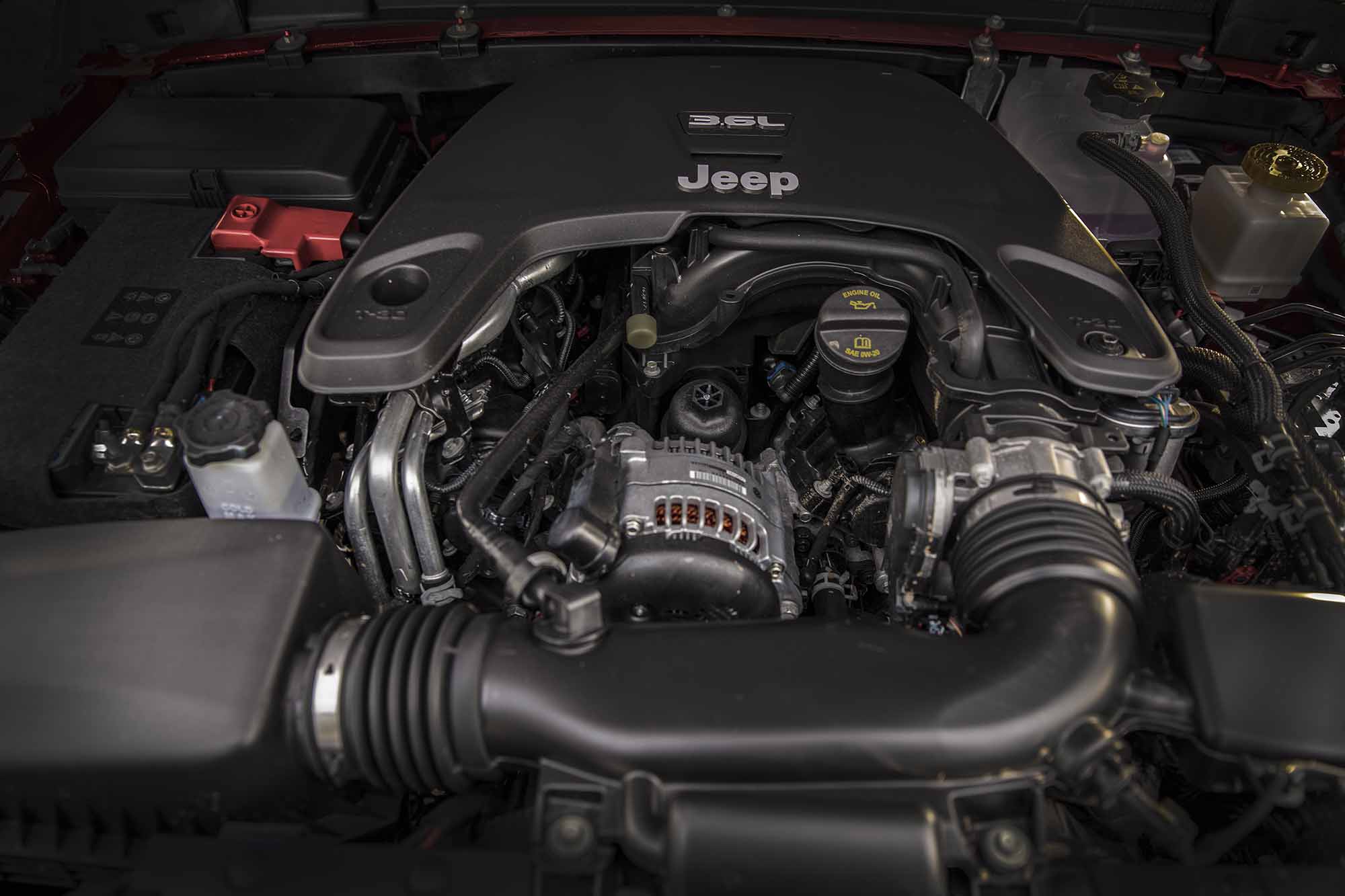
Jeep’s familiar 3.6L “Pentastar” V6 generates 285 horsepower at 6,400 rpm and 260 lb-ft of torque at 4,400 rpm. And it comes paired to a sweet-shifting 8-speed automatic which helped our truck return an even 20 mpg on our 300-mile test. That’s not bad considered the Gladiator is not exactly aerodynamically gifted.
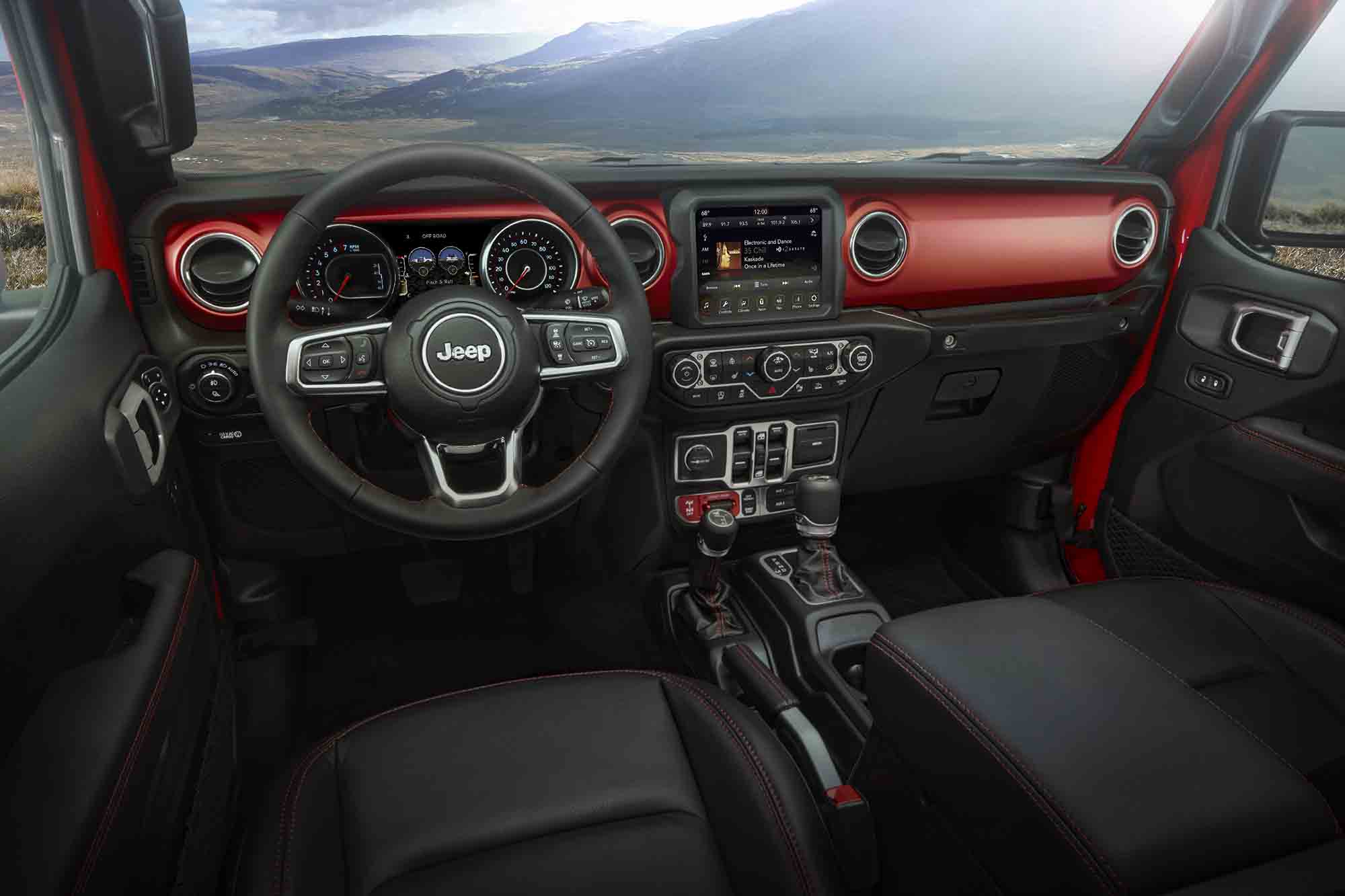
The Gladiator shares most of its interior and cab dimensions with the Wrangler. And that’s no bad thing. The lever actuated 4WD system is clearly the best in class. Under the rear seat are two secure and lockable storage boxes. And the seat back is a split folding design.
On the Street
The Gladiator might share a lot with the Wrangler, but on the road it feels like a more refined vehicle. The ride is much smoother than a JL, and the structure feels stouter, absorbing big potholes without transferring the shock to the cabin. Credit that wheelbase stretch, beefier frame and pirated Ram rear suspension for that. Of course, the drawback to driving a Jeep with such a long wheelbase is agility. The Gladiator certainly requires more three-point turns. It’s easy to think you’re driving a Wrangler and forget that there’s quite a bit more Jeep back there behind the cab. And it is long. The Gladiator has 5 inches over the crew cab Colorado and almost 8 inches over the four-door Ranger.
Pin the throttle to the floor and the Gladiator feels a bit slower than most other mid-size trucks. In fact, our friends at Car and Driver recently tested the Gladiator against three other mid-sizers and found the Overland model it tested to be the slowest, hitting 60 mph in 7.2 seconds. The Colorado was one full second quicker and that’s significant. Still, the Jeep isn’t exactly pokey. And, in regular use, we found the powertrain’s thrust to be totally adequate. However, we do wonder how it might feel loaded down with gear and a trailer. Perhaps the diesel version is worth waiting for.
On the freeway our 4.10:1 geared test truck was much quieter and more stable than the last Wrangler we tested. Of course, our truck had the optional hardtop. A soft top JT would almost certainly generate more wind noise. At 70 mph on the flatter highway sections around Los Angeles, the Gladiator loafed along at 2,000 rpm in top gear. We did notice a bit of freeway hop, typical of most pickups. On the steeper highway grades leading to the off-road park, the Gladiator spent most of its time hunting between seventh gear (2,500 rpm) and sixth (3,000 rpm) to maintain 70 mph. Take a look at the Gladiator’s grill closely and you’ll notice it’s not identical to the Wrangler. Some of the slots have been opened up to increase airflow and make sure this Jeep keeps its cool when pulling trailers on steep grades like this.
Later that day, a “High Wind Warning” came up on the Jeep’s 7-inch infotainment screen. As gusts jostled the Jeep, along with every other vehicle on the road, it was clear the longer wheelbase and those wide track axles were advantageous. The JT’s stability in these strong winds was impressive.
After our 300-mile trek, the Jeep returned exactly 20 mpg. That’s right in the middle of its EPA rating of 17 mpg city and 22 mpg highway. That fuel economy performance is tied with the last Tacoma Sport we tested (20.2 mpg) and within 1 mpg of a Z71 Colorado, the fuel economy midsize champ. So even with the Jeep’s boxy design, it’s good to know this rig is no gas hog.
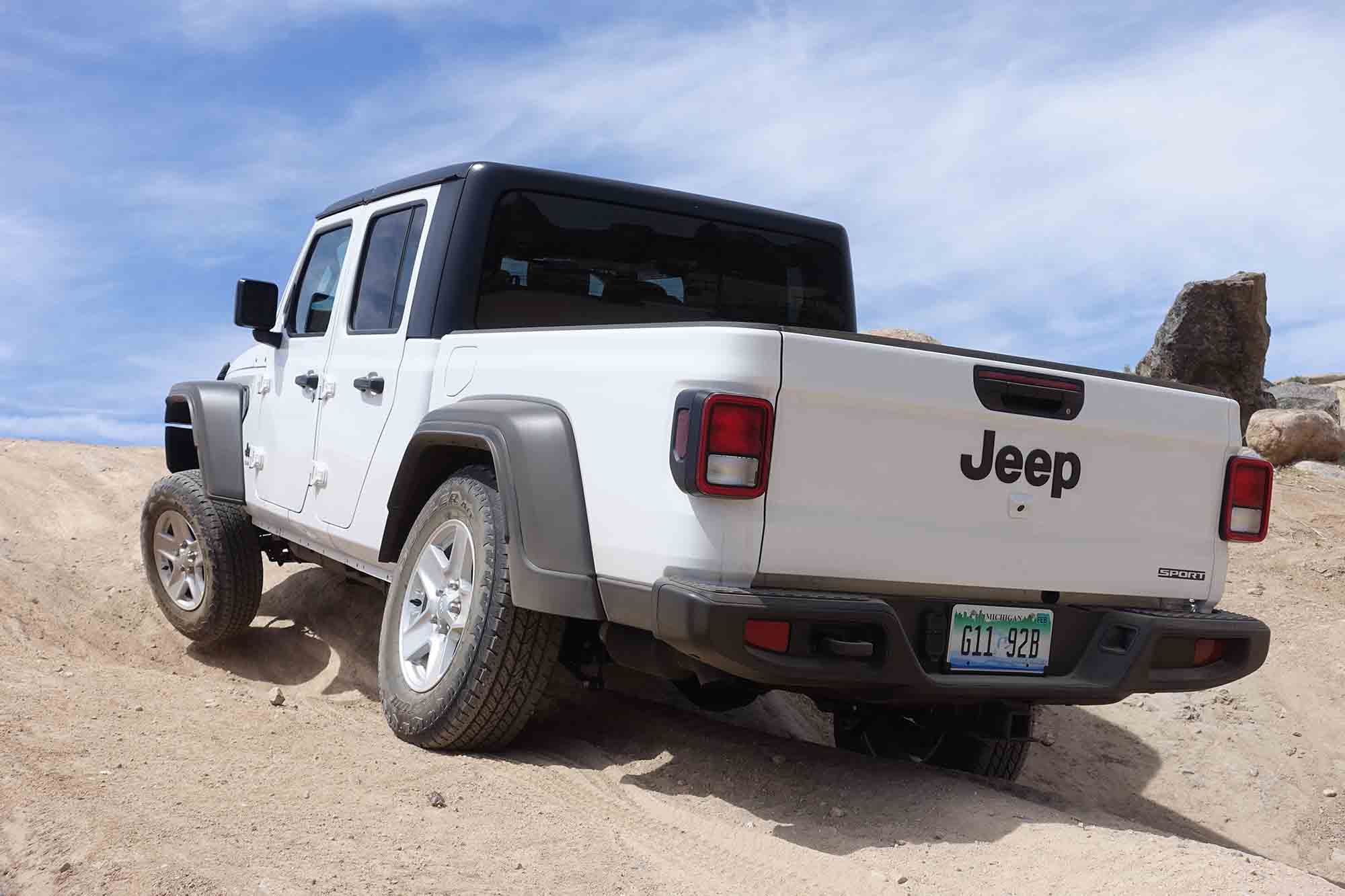
The Gladiator was at home four-wheeling around our local off-road park. Despite mild tires and no locking differentials, the Gladiator could master spots that typically pose a challenge to mid-size pickups that lack specialized off-road equipment. However, the long wheelbase and rear overhang make steep ascents and descents more difficult in the JT than they are in a JL.
On the Trail
As soon as the Gladiator touches dirt, it’s clear this is a real Jeep. There are almost 10-inches of ground clearance under those beefy solid axles. And the approach angle of 40.8 degrees makes tackling obstacles relatively fear free. We were able to cruise around the off-road park in 2WD with some degree of confidence that the Gladiator’s articulation would keep the rear tires in contact with the ground over mild terrain. There’s a confidence and ease when driving in the dirt that we’ve felt in every Wrangler we’ve ever tested. And that same feeling carries through to the Gladiator.
Slide that beefy lever back into low range and the Gladiator has no trouble flexing its way up our rutted test trail. Even without lockers, the Gladiator’s impressive articulation, gearing, and excellent traction control system easily make this the most capable mid-size truck in slow speed four-wheeling. Yes, the Colorado ZR2 is more talented in some areas, but it’s a specialized off-road package. The Gladiator Sport is the base trim level and rides on mild street-tread tires.
On our hill climb tests, the Gladiator was able to conquer a moderate route. Second gear and a bit of throttle helped to overcome the lack of tire traction and reach the top. And, returning to the bottom was easy with the Gladiator’s supremely effective hill descent control. But on the steepest and most extreme hill, the mighty Gladiator just didn’t have the breakover angle to crest the pointy peak. And that might be the Achilles Heel of this truck. A four-door Wrangler Sport riding on the same size tires has a breakover angle of 20.3 degrees. In our Gladiator Sport it’s 18.4 degrees. The plummet in departure angle is more severe, going from 36.1 degrees down to 25. Numbers are one thing, but when they translate into a real-world decrease in capability, they are tough to ignore. Still, we were cautious and aware of the extra bed length hanging behind the rear axle. We never once touched down onto that rear bumper. The same cannot be said for the middle of the truck, where on one trail section we scraped the Gladiator’s belly, but not enough to get high centered.
Back in 2WD, the deep sand washes created a bit of rear axle hop. But the condition wasn’t severe enough to back out of the throttle. Still, this truck likes 4WD. And in 4WD high range, it had an easy time roosting through the wash. Of course, the long-wheelbase Gladiator is considerably less tossable and fun here than a Wrangler. On the higher speed fire roads, the ride was smooth although we did notice that the front suspension felt either under sprung or underdamped for the work we asked of it. It seemed like the front and rear suspensions were less balanced here than the Wranglers we’ve driven on this section.
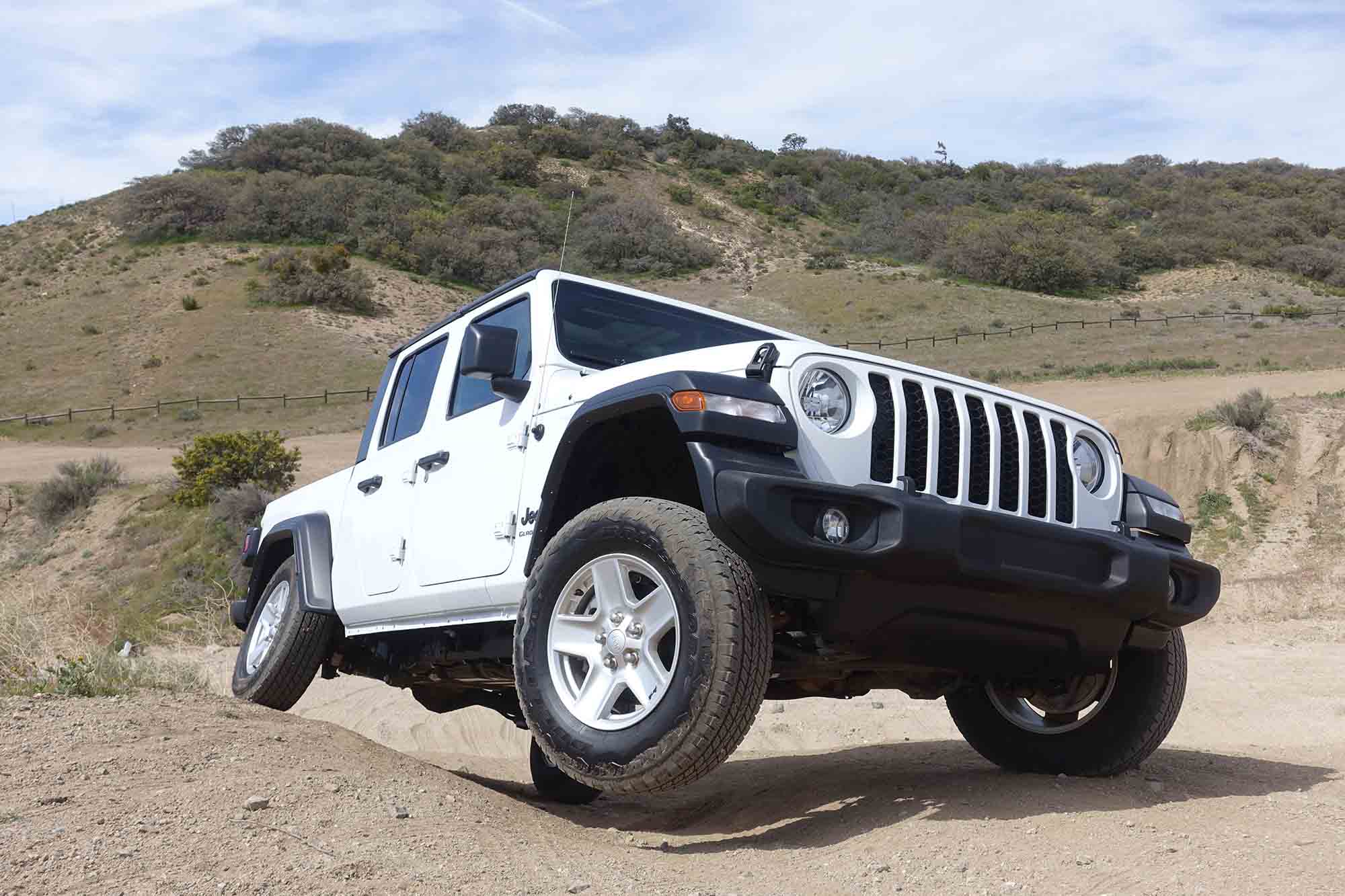
The 2020 Gladiator JT that we were able to get our hands on to test was a a Sport model. Even though it was moderately equipped with options, it still came in at $47,300. That is a lot of money for a mid-size truck and even more than the Chevrolet Colorado ZR2.
The Bottom Line
The Gladiator is one truck that’s easy to fall for. It looks great, it’s competent, it’s useful, and it has a drivetrain that hardcore off-roaders really appreciate. But this is one very long Jeep. And, because of that, it really needs a small lift and larger tires. Besides, this is not a cheap truck. A fully loaded Rubicon can blow right past the $60,000 mark. The base price for a Gladiator Sport S is a more reasonable $38,240. But our truck had the $2,000 automatic transmission, $1,195 hard top, $995 7-inch radio group, $295 wireless speaker, $995 Max Tow package, $995 Cold Weather package, an $895 cargo management system, and a $495 bedliner for a grand total of $47,300. That’s a lot of money for a moderately optioned mid-size truck. The Gladiator is a great truck though, and totally worth the wait. But to avoid sticker shock, go light on the options—especially if a lift, larger tires and other goodies are part of the long-term plan.



2